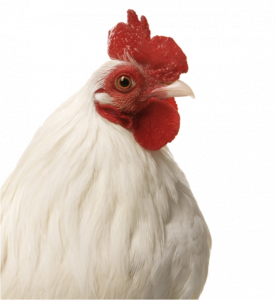
The chicken is a master of disguise. We buy it naked, and yet it still manages to trick us into thinking it is a lean white meat ready to help us increase our protein intake, while minimizing fat. Let’s take a closer look to see what this naked bird looks like without its disguise.
For many years we have been told about the benefits of chicken. It was considered good lean meat because it had higher protein content than fat. However, times have changed but the message has remained the same. In many cases nowadays, our chicken has higher fat than protein.
Did we miss something? Unannounced to us, did our chicken go on strike and decide that it no longer wanted to have higher protein? No. Unfortunately, in this situation the chicken had no choice. This problem has occurred because of how we raise chickens. For an overwhelming majority, gone are the days where they can run free, get exercise and eat grass, bugs, etc. We now manufacture them like products, packing them by the thousand into a barn with no room to exercise, feeding them high-energy food so they bulk up fast, and giving them antibiotics so they don’t get sick in these conditions.
- Problem 1: No exercise makes the birds fat – this fat is passed on to the consumer.
- Problem 2: Chickens are fed cheap food made of seeds which makes them get fat and weigh more, but the extra weight is fat not protein. Factory farmed chickens are not given the grass and protein they require. Not only has this affected their fat to protein ratio, it has also increased the amount of Omega 6 fatty acids while decreasing the Omega 3 fatty acids. In a healthy chicken these would be balanced offering us health benefits such as helping to lower bad cholesterol, heart health, etc.
Animal rights issues aside; this rearing process has affected the food we eat. I guess no one considered what would happen to the nutritional value of the chicken and how that would ultimately affect us!
So if the chickens are losing, and we are losing, who is winning? Well, farmers are able to raise more chickens at a lower cost and therefore increase their profits. Grocery stores are able to buy cheaper chickens allowing them to drop the price and increase the quantity sold to consumers. This increase in consumption provides more money for chicken food boards to advertise and tell us to consume more of this healthy lean white meat. It seems to me that the driver for changing the nutritional value of our chickens is money and not our overall wellbeing.
The purpose of this article is not to get you to stop eating chicken but to help you better understand what’s in it and therefore make healthier choices when shopping and considering the amount of chicken to consume. So what’s next? Here are a few tips to keep in mind when shopping for chicken:
- Ignore the following terms as they are merely creative verbiage used by the industry to try and trick us into thinking we are buying a healthier product:
- 100% natural: This term doesn’t really mean much at all.
- Cage-free: These birds are not stored in individual cages but could still have been factory farmed.
- Hormone-free: All chickens are hormone free as law prohibits hormones in poultry.
- Free-range: This only means that the chickens are “allowed” to go outside for a couple weeks of their life.
- Keep an eye out for terms like “no antibiotics used”, “certified humane”, and “pastured poultry”/”grass-ranged poultry”. These terms better indicate how the chicken was raised. This is a good place to start when looking for healthier and tastier chicken.
- Read the labels and avoid chickens that have added ingredients such as water, glucose, preservatives, and stabilizers.
- It is also helpful to buy organic meat, however an organic chicken could still have been factory farmed, so the term is often not enough all on its own.
- Don’t always trust your local grocery store to offer you the best quality meat. Ask the right questions and where possible seek out local farms/butchers as they often provide healthier options.
Now that we have exposed the naughty secrets of so many chickens, we are better able to make healthy choices.
For More Information: Here is a documentary that I watched and found helpful. Supermarket Secrets was filmed in the UK. A large portion of the movie focuses on the nutritional value of our meat products and how they have changed due to rearing practices.
To watch, click the button on the bottom left of the video to expand and play.


